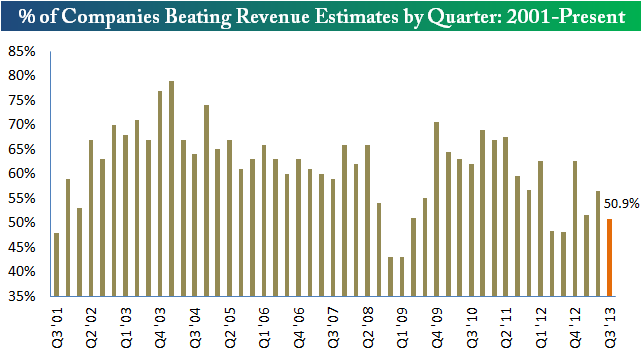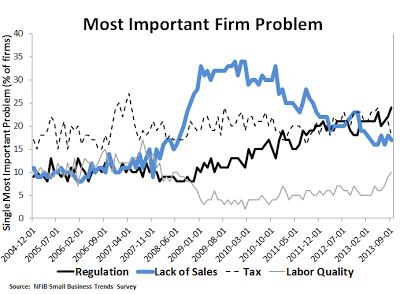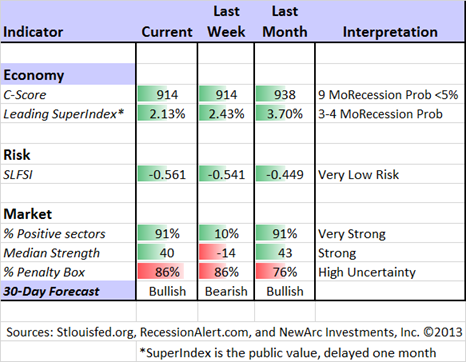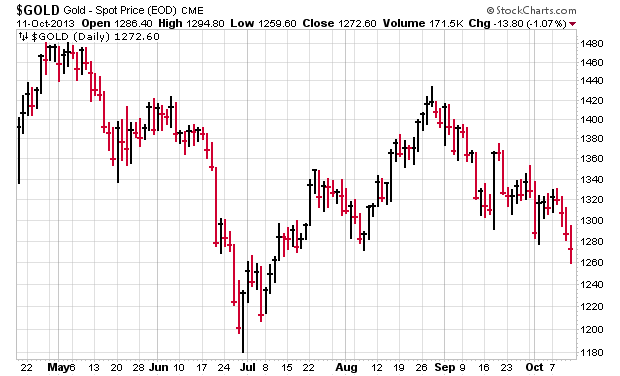It is time for a return to normalcy!
I expect much less Washington politics and much more focus on corporate earnings. While economic data reports are still delayed and distorted, we will gradually get back to analysis of economic fundamentals as well.
Last week's theme emphasized the end of the apparent Washington stalemate – no default and a compromise with a smidgen of face saving. I suggested the following:
Daily trading will react and over-react to each piece of news, beginning with a soft opening tomorrow. This will all soon be forgotten, with a renewed focus on corporate fundamentals.
If anything, I was a little too pessimistic. I thought that Senate objections could delay the resolution by a couple of days. Sen. Cruz chose not to filibuster, so the Thursday "deadline" was met. Overall, my analysis of the political shenanigans has been accurate.
The Earnings Question
Ed Yardeni echoes a theme we have cited in recent weeks. (See Brian Gilmartin as well). Yardeni notes a rise in forward earnings and the strong link to actual earnings, including this chart:
Yardeni expects the current earnings season to be "unsurprising." He notes that there is a multi-quarter pattern. Earnings beat expectations and analysts immediately reduce guidance for the next quarter. If one takes a longer outlook, the picture remains quite positive.
I have some additional ideas on other themes to follow in the week ahead. I'll report on those in the conclusion. First, let us do our regular update of last week's news and data.
Background on "Weighing the Week Ahead"
There are many good lists of upcoming events. One source I regularly follow is the weekly calendar from Investing.com. For best results you need to select the date range from the calendar displayed on the site. You will be rewarded with a comprehensive list of data and events from all over the world. It takes a little practice, but it is worth it.
In contrast, I highlight a smaller group of events, including some you have not seen elsewhere. My theme is an expert guess about what we will be watching on TV and reading in the mainstream media. It is a focus on what I think is important for my trading and client portfolios. Each week I consider the upcoming calendar and the current market, predicting the main theme we should expect. This step is an important part of my trading preparation and planning. It takes more hours than you can imagine.
My record is pretty good. If you review the list of titles it looks like a history of market concerns. Wrong! The thing to note is that I highlighted each topic the week before it grabbed the attention. I find it useful to reflect on the key theme for the week ahead, and I hope you will as well.
This is unlike my other articles where I develop a focused, logical argument with supporting data on a single theme. Here I am simply sharing my conclusions. Sometimes these are topics that I have already written about, and others are on my agenda. I am putting the news in context.
Readers often disagree with my conclusions. Do not be bashful. Join in and comment about what we should expect in the days ahead. This weekly piece emphasizes my opinions about what is really important and how to put the news in context. I have had great success with my approach, but feel free to disagree. That is what makes a market!
Last Week's Data
Each week I break down events into good and bad. Often there is "ugly" and on rare occasions something really good. My working definition of "good" has two components:
- The news is market-friendly. Our personal policy preferences are not relevant for this test. And especially -- no politics.
- It is better than expectations.
The Good
With the shutdown limiting issuance of fresh government data, there was much less (non-political stuff) to ponder. There was some good news.
- Private economic indicators are strong. The Bonddad Blog, one of our favorite sources, now publishes their invaluable high-frequency indicators at XE Market Analysis. In the absence of regular government data, these are especially important. This is a helpful and comprehensive article, demonstrating a "positive bounce."
- Rail traffic remains strong, "comfortably ahead of last year" according to Todd Sullivan. Steven Hansen at GEI also slices and dices the data using various time frames.
- China's Economy continues to grow. John Lounsbury at GEI has a very balanced analysis, highlighting the various threats. There is also this helpful graph, providing little support for those who have been predicting a "hard landing" for the last two years:
- Initial jobless claims are encouraging. Most are having difficulty interpreting this series. New Deal Democrat (reporting at XE instead of Bonddad) has done a nice job with the data. He has taken the state data, looked at year-over-year stats, and taken out California. This removes the known source of distortion. It is a week behind, since the state data lags, but it is much better than the headline reports.
The Bad
Despite the data shortage, there was also some bad news.
- Corporate earnings. The Q3 reports are off to a weak start on earnings beats and even worse on revenue. As always, Bespoke has a great summary of the data and helpful analysis, including the following chart about revenues:
- The Beige Book suggests very modest growth. It is difficult to gauge expectations for this report, which consists of anecdotal information to supplement the data used at each FOMC meeting. The preparation rotates among the regional Fed banks. Steven Hansen takes on the challenge of parsing the language, with a rather neutral verdict. The market sold off a touch on the news.
- Structural business problems are on the rise, according to the NFIB. David Beckworth, who writes an excellent economics blog, has been skeptical of the regulation argument, emphasizing lack of demand as the source of economic weakness. This has important policy implications and Beckworth is demonstrating objectivity in noting the change in the data. Here is a key chart:
The Ugly
Shutdown effects. Some will not understand the important economic impacts, no matter how real. These depend upon models and counterfactuals, causing the eyes of most to glaze over. For those who really want to know, I recommend Menzie Chinn's account, showing impacts of up to 1% overall if one includes crisis driven fiscal policy and uncertainty effects.
For those who want tangible examples, I recommend the discussion of the impact on science (via Scientific American). Experiments were interrupted, scientists missed out on trips abroad, surveillance of diseases was halted – and much more. Do you suppose that those in Congress thought about any of these "non-essential" services?
The Silver Bullet
I occasionally give the Silver Bullet award to someone who takes up an unpopular or thankless cause, doing the real work to demonstrate the facts. Think of The Lone Ranger.
This week's award goes to Cullen Roche who is debunking "The Biggest Scam in the History of Mankind." Cullen does a careful analysis of a misleading, but convincing video. The source is a convincing rant on "fiat money" with the intent of selling gold and silver. Cullen's post does a good job of exposing the errors.
[For more on gold, please see the investor section below.]
The Indicator Snapshot
It is important to keep the current news in perspective. I am always searching for the best indicators for our weekly snapshot. I make changes when the evidence warrants. At the moment, my weekly snapshot includes these important summary indicators:
- For financial risk, theSt. Louis Financial Stress Index.
- An updated analysis of recession probability from key sources.
- For market trends, the key measures from our "Felix" ETF model.
Financial Risk
The SLFSI reports with a one-week lag. This means that the reported values do not include last week's market action. The SLFSI has recently edged a bit higher, reflecting increased market volatility. It remains at historically low levels, well out of the trigger range of my pre-determined risk alarm. This is an excellent tool for managing risk objectively, and it has suggested the need for more caution. Before implementing this indicator our team did extensive research, discovering a "warning range" that deserves respect. We identified a reading of 1.1 or higher as a place to consider reducing positions.
The SLFSI is not a market-timing tool, since it does not attempt to predict how people will interpret events. It uses data, mostly from credit markets, to reach an objective risk assessment. The biggest profits come from going all-in when risk is high on this indicator, but so do the biggest losses.
Recession Odds
I feature the C-Score, a weekly interpretation of the best recession indicator I found, Bob Dieli's "aggregate spread." I have now added a series of videos, where Dr. Dieli explains the rationale for his indicator and how it applied in each recession since the 50's. I have organized this so that you can pick a particular recession and see the discussion for that case. Those who are skeptics about the method should start by reviewing the video for that recession. Anyone who spends some time with this will learn a great deal about the history of recessions from a veteran observer.
I also feature RecessionAlert, which combines a variety of different methods, including the ECRI, in developing a Super Index. They offer a free sample report. Anyone following them over the last year would have had useful and profitable guidance on the economy.
RecessionAlert has developed a comprehensive package of economic forecasting and market indicators, including this recent update on the world economy.
Georg Vrba's four-input recession indicator is also benign. "Based on the historic patterns of the unemployment rate indicators prior to recessions one can reasonably conclude that the U.S. economy is not likely to go into recession anytime soon." Georg has other excellent indicators for stocks, bonds, and precious metals at iMarketSignals. For those interested in gold, he has a recent update, asking when there will be a fresh buy signal.
Unfortunately, and despite the inaccuracy of their forecast, the mainstream media features the ECRI. Doug Short has excellent continuing coverage of the ECRI recession prediction, now two years old. Doug updates all of the official indicators used by the NBER and also has a helpful list of articles about recession forecasting. Doug also continues to refresh the best chart update of the major indicators used by the NBER in recession dating.
Readers should review my Recession Resource Page, which explains many of the concepts people get wrong. There is now an updated analysis showing the impact of the government shutdown – moving some measures into "recession warning" territory, as shown by this chart:
Here is our overall summary of the important indicators.
Our "Felix" model is the basis for our "official" vote in the weekly Ticker Sense Blogger Sentiment Poll. We have a long public record for these positions. Over the last month Felix has ranged over the full spectrum – twice! The market has been moving back and forth around important technical levels, driven mostly by news.
Felix does not react to news events, and certainly does not anticipate effects from the headlines. This is usually a sound idea, helping the trading program to stay on the right side of major market moves. Abrupt changes in market direction will send sectors to the penalty box. The Ticker Sense poll asks for a one-month forecast. Felix has a three-week horizon, which is pretty close. We run the model daily, and adjust our outlook as needed.
The penalty box percentage has remained elevated, meaning that we have less confidence in the overall ratings.
[For more on the penalty box see this article. For more on the system ratings, you can write to etf at newarc dot com for our free report package or to be added to the (free) weekly ETF email list. You can also write personally to me with questions or comments, and I'll do my best to answer.]
The Week Ahead
This week's schedule brings more releases than usual, but the data will be more backward-looking than usual. Despite the extra reports, there are several more that are on a continued delay.
The "A List" includes the following:
- Employment situation report (T). This is the report for September, based on data for the week beginning on September 9th. This delay came from data compiling. Next month's report will also be delayed due effects on data collection.
- New home sales (Th). Important as a read on both the consumer and construction.
- Michigan sentiment (F). The data reflect the period before the debt ceiling and shutdown agreements. Weak sentiment was a big drag after the 2011 debt ceiling deal, so this bears watching.
The "B List" includes:
- Initial jobless claims (Th). Less interesting than usual because of the California and shutdown effects.
- Existing home sales (M). Housing remains key to a continued economic recovery.
- Durable goods (F). Significant element of GDP.
There are many lesser releases, which are unlikely to have any real effect.
Most important of all will be Q3 earnings news – now in the heart of the reporting season.
How to Use the Weekly Data Updates
In the WTWA series I try to share what I am thinking as I prepare for the coming week. I write each post as if I were speaking directly to one of my clients. Each client is different, so I have five different programs ranging from very conservative bond ladders to very aggressive trading programs. It is not a "one size fits all" approach.
To get the maximum benefit from my updates you need to have a self-assessment of your objectives. Are you most interested in preserving wealth? Or like most of us, do you still need to create wealth? How much risk is right for your temperament and circumstances?
My weekly insights often suggest a different course of action depending upon your objectives and time frames. They also accurately describe what I am doing in the programs I manage.
Insight for Traders
Felix has switched back to bullish. For our trading accounts we were never actually short, since the inverse ETFs were in the penalty box. We were only 2/3 long and the positions were rather defensive. Felix's ratings have been in a fairly narrow range for several months. The rapid news-driven shifts are not the ideal conditions for Felix's three-week horizon. The high penalty box rating continues to underscore the uncertainty. The result is that Felix showed some profit during the Washington debate, while taking a lot less risk.
Insight for Investors
I review the themes here each week and refresh when needed. For investors, as we would expect, the key ideas may stay on the list longer than the updates for traders.
- Headlines. The challenge for investors is to distinguish between the major trends and the short-term uncertainty. The main themes are not related to headlines news, even though sentiment may drive market fluctuations. Do not be seduced by the idea that you can time the market, calling every 10% correction. Many claim this ability, but few have a documented record to prove it. Most who claim past success are using a back-tested model. Please see The Seduction of Market Timing.
- Risk Management. It is far better to manage your risk, specifically considering the role of bonds and the risk of bond mutual funds. As I emphasized, "You need to choose the right level of risk!" Right now, it is the most important question for investors. There is plenty of "headline risk" that may not really translate into lower stock prices. Instead of reacting to news, the long-term investor should emphasize broad themes.
- Getting back in. Those who have tried to time the market by selling stocks before the shutdown now must decide when to get back in. Josh Brown, who has at least one special nugget for investors each week. This week he had two.
- Josh writes as follows:
The timers and tactical guys will now point to inflation-adjusted measures to convince you that it's not a record high but it is. The newsletter guys will rail about the Fed as they have been for five years now and the TV people will obsess over whether or not you should be "playing it" with retailers or banks or tech stocks.
Take a moment, from this peak - or way-station toward some higher, future peak - to reflect on who's been wasting your time and distracting you from your retirement goals.
One of our best commenters, "Left Banker," is now contributing at Seeking Alpha. Welcome! Everyone should read his posts. Get started with his analysis of inflation adjusted cycles and why you should consider "buying in October." - Josh also notes a long list of things that could have gone wrong, but didn't. He sees this as "rocket fuel" and asks,
"What happens from here? My guess would be that we have all the rocket fuel we need for an explosion."
- Josh writes as follows:
- Avoiding the "fear trade." One of the most profitable activities for an investment manager or a writer is to recommend the purchase of gold. Commissions are high and so is the traffic and advertising revenue. Fear sells! Izabella Kaminska of FT Alphaville does a great takedown on the shallow reasoning from a typical gold site. There is no way to summarize this properly, so just read it. On a similar theme, Eddy Elfenbein thinks that it might be the popping of the "fear bubble." I have a special program for those who are overloaded on precious metals, achieving the same ends without the single-metal risk. Eddy includes this chart:
And finally, we have collected some of our recent recommendations in a new investor resource page -- a starting point for the long-term investor. (Comments and suggestions welcome. I am trying to be helpful and I love feedback).
Final Thought
There are several new themes that I will be watching next week.
- Good news will be good. And bad news will be bad. With the Fed expected to be on hold for the foreseeable future, the market should celebrate economic strength and good earnings – and be disappointed by the opposite.
- Volatility will be lower. We will get a respite from headlines.
- Those who have been completely wrong will find new excuses. Those who claim that politicians are "kicking the can" should look in the mirror. Failed pundits merely extend the time frame for their mistakes.
Cardiff Garcia has a very nice analysis of why last week's compromise might actually work out. He draws upon an analysis from Barclays and features several key charts, concluding as follows:
Still, the chance of another shutdown does seem low. And the strategists did leave out the obvious but important point that 2014 is an election year. Given the disastrous outcome for Republicans this time round, their leadership is unlikely to want a reenactment of the last few weeks.
I strongly agree, and suggested in this post how investors might actually profit from the skepticism. I am looking for opportunity in the week ahead.







